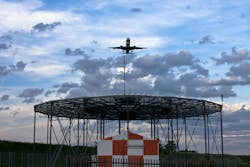Safer Skies: Mitigating 5G C-Band Interference with Aircraft Radio Altimeters
Possibly the only thing growing faster than post-pandemic enplanements (travel) is the rollout of 5G. In North America, for example, the number of 5G connections grew 292% over the course of 2021, according to Omdia. By 2025, 5G will displace 4G as the dominant technology, with 63% of the North American market, GSMA Intelligence predicts.
But there are growing pains, starting with spectrum. To meet the insatiable demand for mobile connectivity, the FCC spent the past decade scrounging for every available bit of spectrum to reallocate for cellular. One of those new blocks is C-band spectrum, which is 3.7-3.98 GHz. As Figure 1 shows, that’s next door to the Aeronautical Radionavigation Service (ARNS) band at 4.2-4.4 GHz band. This spectrum is used by radio altimeters (RADALTs), which aircraft rely on during takeoffs and landings.
This proximity creates the potential for 5G base stations located at or near airports to interfere with RADALTs. This risk got mainstream media attention in late 2021 and early 2022 as mobile operators such as AT&T and Verizon prepared to turn on their C-band sites. As the debate played out the spotlight, airlines cancelled flights and some operators temporarily delayed 5G site launches.
Operators have a vested interest in mitigating interference because airports have a lot of people with a lot of time on their hands. C-band spectrum is critical for providing those customers with the coverage, capacity and 5G speeds they need to stream Netflix, upload photos, videoconference and more. Operators that can’t meet that demand and customer expectations risk losing those subscribers—including the coveted business traveler segment—to rivals.
Sensitive and Susceptible
Resolving this situation requires expertise in both mobile and avionics because both are highly complex. For example, civil and military RADALT systems use either unmodulated pulse radar or frequency-modulated continuous wave (FMCW) radar. The aircraft transmits a signal toward the ground and receives a portion back, and then uses the round-trip propagation time to calculate its above-ground level (AGL) altitude.
The returning signals can be very weak, so highly sensitive receivers are required to ensure that the RADALT system works consistently and reliably. But this sensitivity also makes them susceptible to interference—including from 5G signals slopping over from the C-band—which can undermine their accuracy.
This is not a minor risk. Pilots are particularly reliant on RADALT during low-visibility conditions. For example, adjacent-channel interference could cause the system to conclude that there’s a hill in the flight path, prompting the pilot to take a sudden evasive maneuver that’s unnecessary and even dangerous. In other cases, the interference could cause the system to miscalculate the AGL as being at a safer distance than it actually is and fail to warn the pilot.
When it was allocating the C-band, the FCC anticipated these risks and created a 3.98-4.0 GHz guard band. The ARNS band already had its own 4.0.-4.2 GHz guard band, for a combined buffer of 40 MHz. Even so, the radar altimeter receiver may be unable to sufficiently filter a strong 5G signal outside of its normal receive bandwidth, leading to problems such as front-end overload.
Another factor is the C-band spectrum itself. Compared to cellular’s traditional sub-2.5 GHz bands, 3.7-3.98 GHz requires a much higher density of cell sites in a given area because signals don’t travel as far at higher frequencies. More sites in and around an airport means more opportunities for interference with RADALT systems. Travelers’ 5G smartphones and tablets also become sources of interference when they transmit in the C-band. At a busy airport, that could mean thousands of user devices adding to the cacophony of signals that radar altimeter receivers must contend with.
5G architecture also creates variables. A prime example is beamforming, a technique that base stations use to focus the signal on each user device to maximize performance. In the process, this technique increases the signal strength in a given area and thus the potential for interference.
"Operators have a vested interest in mitigating interference because airports have a lot of people with a lot of time on their hands. C-band spectrum is critical for providing those customers with the coverage, capacity and 5G speeds they need to stream Netflix, upload photos, videoconference and more."
Cleared for Takeoff
On the plus side, 5G architecture also has features that could benefit RADALT systems. For example, 5G base stations operate in time-division-duplex (TDD) mode, where they transmit some of the time and then spend the rest receiving signals from user devices. Operators can configure TDD mode so the RADALT can operate successfully even when the 5G signals cause interference.
TDD configuration also is an example of why expertise in both cellular and avionics is critical for maximizing RADALT performance and reliability. This expertise can be leveraged in the form of testbed products designed to analyze how 5G C-band signals are interacting with RADALT systems—both in a lab and in the real world. These analytics give mobile operators, airports, avionic systems manufacturers, and airlines the insights necessary to identify potential problems before they result in dangerous situations, and then develop procedures to mitigate those risks.
One example is a radio altimeter test set that supports static and dynamic altitude simulations, as well as true RF time delay and path loss models. Those simulations also should be highly granular, such as anywhere between 0 feet and 10,000 feet in 10-foot steps. This enables the tests to cover all of the potential climb and descend scenarios, with interference at each step, as illustrated in Figure 2. The interfering signals also should be user-definable because each airport has a unique RF environment.
Two other valuable tools are multi-protocol testers and RF spectrum analyzers, which can be combined into a single, multi-purpose solution. This combination is ideal for testing all types of 5G C-band base stations that are used in and around airports, including small cells, macrocells and distributed antenna systems. The tool also should be able to log and characterize signals to help identify sources of intermittent interference. For example, the TDD architecture means that a single frequency channel will have multiple time slots for uplink and downlink signals, while beamforming highlights the importance of being able to identify the presence and location of those signals.
These kinds of test tools will be key for providing airports, airlines and passengers with the peace of mind they deserve—and the freedom to take full advantage of 5G.
ABOUT THE AUTHOR
Dr. Sameh Yamany is an experienced Chief Technology Officer with a demonstrated history in technology innovations and development leadership of top market share, winning commercial solutions in 5G, 4G, LTEx, IoT, geolocation, assurance, artificial intelligence, and machine learning applications. For more information, please email [email protected] or visit viavisolutions.com. You can also follow him on Twitter @samehyamany. Follow VIAVI Solutions on Twitter @viavisolutions, Facebook @viavisolutions and Instagram @viavifiber.
About the Author
Dr. Sameh Yamany
Chief Technology Officer, VIAVI Solutions
Dr. Sameh Yamany is an experienced Chief Technology Officer with a demonstrated history in technology innovations and development leadership of top market share, winning commercial solutions in 5G, 4G, LTEx, IoT, geolocation, assurance, artificial intelligence, and machine learning applications. For more information, please email [email protected] or visit viavisolutions.com. You can also follow him on Twitter @samehyamany. Follow VIAVI Solutions on Twitter @viavisolutions, Facebook @viavisolutions and Instagram @viavifiber.



